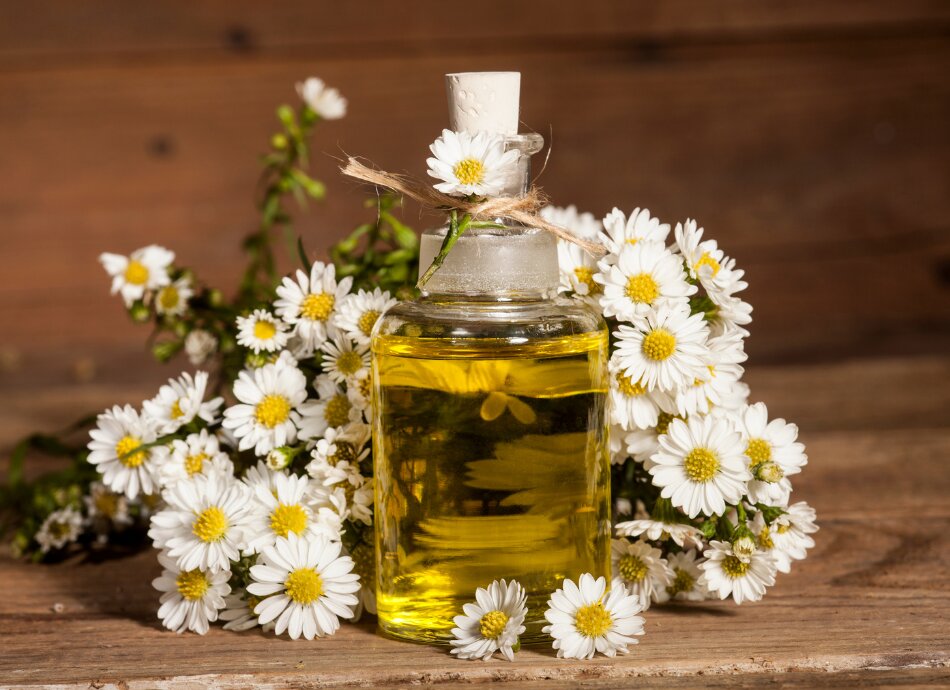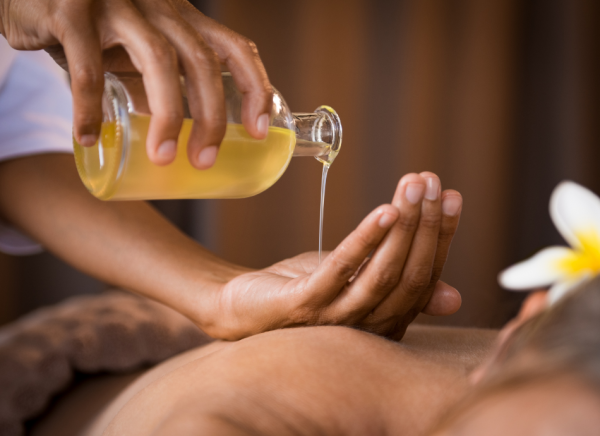Essential oils
Also called aromatherapy
Key points about essential oils
- Essential oils are made from parts of certain plants, such as leaves, bark, seeds or rinds.
- They might be used on your skin, inhaled, or put into your bath water.
- If they're not used correctly, essential oils can be harmful. They should never be swallowed.
- Always do a skin patch test before using a new essential oil. There are some oils that can cause a skin condition called contact allergic dermatitis.
- Ask your healthcare provider if they’re safe for you to use before you use them.

Essential oils are highly concentrated extracts from the flowers, leaves, seed, bark, roots or peel of a plant. They may smell citrusy, woody, minty, floral, or spicy. Essential oils can be a mix of many ingredients.
Essential oils can be applied to, or massaged into your skin, inhaled (breathed in) or added to bath water. They’re most commonly used in aromatherapy, which is sometimes known as essential oil therapy. Essential oils aren’t regulated as a medicine product in Aotearoa New Zealand and they're not approved by Medsafe. They’re classified as complementary and alternative medicines. Read more about complementary and alternative medicine.
Essential oils have been widely used for many years in aromatherapy (applied to the skin or inhaled), balneotherapy (bathing in waters) and in perfumes. People report experiencing benefits such as improved mood, pain relief, reduced anxiety and better digestion.
Some common ingredients in essential oils and their uses include:
The uses of some common ingredients in essential oils include:
- eucalyptus oil – nasal decongestant, disinfectant
- clove – toothaches
- peppermint – digestive problems, headache and migraine relief
- lavender – anxiety, sleep problems and restlessness
- mānuka oil (tea tree oil) – soothing skin irritation and treating minor skin infections
- kānuka oil – soothing skin irritation.

Image credit: Canva
Essential oils are also used in diffusers, as home perfumes, in cleaning products, and to freshen up laundry. Other uses include as a natural insect repellent (citronella candles, creams) and to scent homemade cosmetics. Essential oils are also used in some aspects of rongoā Māori, for example manūka and kānuka oil. Read more about rongoā Māori.
Essential oils are not always safe. They are very strong and can be harmful if used the wrong way.
Be careful – essential oils are highly concentrated
Essential oils come from plants, but they are much more concentrated than the plants themselves. They are made by removing parts of the plant and making them very concentrated. Because of this, only a few drops of essential oil are needed to have an effect. Using too much or using them the wrong way can cause skin irritation, allergic reactions, or other problems.
Never swallow essential oils because even a small amount can be poisonous
If swallowed, essential oils are absorbed rapidly, and symptoms can develop as quickly as a few minutes later. Some people have delayed symptoms that develop hours after exposure. Symptoms include nausea, tummy pain, vomiting blood, loss of consciousness, seizures.
Before applying them to your skin
Always dilute by mixing them with another oil (a carrier oil such as coconut oil) before using them so they don’t cause irritation or allergies. The amount they are diluted is important. Read more about how to use carrier oils(external link).
Skin reactions including allergic reactions are more likely and severe with undiluted oils. Symptoms include rash, irritation, hives, burning, blistering. Allergic contact dermatitis is a delayed reaction which can occur when oil is applied to your skin. It can also occur from fragrance diffusers. If you have a skin condition or have reacted to skin products before, you may be more likely to have a reaction.
To use an essential oil safely, dilute it appropriately and apply some to a small patch of skin. Wait 24 to 72 hours to see if there is a reaction before using it again. If you get a red, itchy rash or hives after applying essential oils, you may be having an allergic reaction.
It’s important to keep essential oils out of reach of children and pets. Read more below.
Some oils also have ingredients that can interfere with medicines or conditions such as asthma or seizures.
Play it safe
Talk to your healthcare provider before using essential oils, especially if you have a health condition or take medication.
Are essential oils safe during pregnancy?
Talk with your healthcare provider or midwife before using any essential oils while you're pregnant as they may affect the developing baby.
Using your essential oils in a diffuser rather than applying them to your skin is a safer option but, again, talk to your healthcare provider or midwife first and they can advise you.
Are essential oils safe during labour?
Talk to your doctor, midwife, or nurse before using any oils during labour. Using a diffuser with certain oils during aromatherapy might contribute to a calm and comforting environment., however, the evidence on how effective or safe essential oils are during labour is still unclear. Always talk to your doctor, midwife, or nurse before using any oils to learn which ones are safe and how to use them for symptom relief.
Are essential oils safe for children?
Never let your child swallow products containing essential oils. To avoid accidents, these products, including those used in vaporisers, must be stored securely in a child-resistant containers and kept out of reach of tamariki. As little as a few drops (less than half a teaspoon) of eucalyptus oil can cause significant poisoning in an infant.
Be careful when applying essential oil products to children’s skin because their skin is more sensitive and they are more likely to have side effects.
Peppermint oil used on children under 30 months of age can increase the risk of seizures.
Read more about what to do in an emergency.(external link)
Are essential oils safe for pets?
For most pets, especially cats, essential oils aren’t safe and can be toxic if swallowed, sniffed, or applied to the skin or fur. Talk to your vet about any concerns or questions you might have.
Just because something is natural doesn’t mean it’s safe. Many essential oils can be poisonous if ingested or swallowed. They can cause side effects like:
- rashes
- asthma attacks
- headaches
- allergic reactions.
Here are some dos and don'ts of essential oils
Do
- Do buy high quality oils.
- Do dilute essential oils by blending a few drops with a carrier oil such as almond, jojoba or coconut oil before applying to your skin.
- Do test on a small patch of skin before you use it.
Don’t
- Don’t swallow essential oils.
- Don’t use essential oils on children and pets.
- Don’t continue applying it if it irritates your skin
- Don't use them in pregnancy until you've talked to your healthcare provider or midwife about how to use them safely.
It’s not clear if essential oils are useful for treating conditions. While they may help improve mood and ease minor problems such as anxiety, stress, or nausea, this may be because their smell can affect the parts of the brain that control emotions. However, there’s not enough strong scientific proof that they can cure diseases. They’re very concentrated, so they can cause side effects or interact with medicines. That’s why it’s important to use them safely and with caution.
Essential oils – health warning(external link) Department of Health, Western Australia
References
- Are essential oils safe? 13 things to know before use(external link) Healthline, US, 2024
- What are essential oils?(external link) Healthline, US, 2019
- Using essential oils safely during pregnancy(external link) Healthline, US, 2021
- Do’s and don’ts of essential oils(external link) WebMD, US, 2025
- What to know about essential oils during labour(external link) WebMD, US, 2025
- Allergic contact dermatitis to essential oils(external link) DermNet, NZ, 2020
- Do essential oils expire?(external link) Healthline, US
Where can I buy essential oils in New Zealand?
Natural health stores and pharmacies stock essential oils for aromatherapy, skincare and wellness. New Zealand-based websites offering natural products may also offer a wide range of locally sourced and organic options.
What essential oils are safe for cats and dogs?
For most pets, especially cats, many essential oils aren’t safe and can be poisonous if swallowed, sniffed, or applied to the skin or fur. Cats are more sensitive than dogs as they don't have the liver enzymes that metabolise many essential oil compounds. Always talk to your vet first.
Can essential oils expire?
While most essential oils don’t have an expiry date, be aware that their chemical compounds can change as they get older. Most essential oils last 1 to 3 years, depending on the type and how they are stored.
Oils high in citrus (eg, lemon, orange, bergamot) tend to oxidize faster and may expire sooner than others.
Signs of expiry include:
- change in smell (rancid or faded aroma)
- change in colour or consistency
- increased risk of skin irritation if used.
Credits: Healthify editorial team. Healthify is brought to you by health Navigator Charitable Trust.
Reviewed by: Healthify editorial team
Last reviewed:





